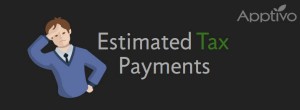 Small business owners have to pay estimated tax quarterly and should not wait till April 15 or when other type of tax payers file their respective returns. These quarterly payments are for the amount the small businesses estimate that they owe the government. In case estimated tax payments are not paid timely, the small business might have to pay heavy penalties which is the interest amount for the overdue quarterly payments.
Small business owners have to pay estimated tax quarterly and should not wait till April 15 or when other type of tax payers file their respective returns. These quarterly payments are for the amount the small businesses estimate that they owe the government. In case estimated tax payments are not paid timely, the small business might have to pay heavy penalties which is the interest amount for the overdue quarterly payments.
For small businesses estimated income tax payments is a necessity. They have to periodically deposit an amount termed “estimated tax payments” to the Internal Revenue Service (IRS.)It may also be necessary to pay estimated tax payments to the state taxing authority.
Estimated tax payment schedule
In case you are a small business owner, remember to take the tax calendar into consideration while making your yearly budget. This is the following schedule for the estimated tax payments as per Federal Income Tax regulations this year.
- April 15, 2016 (first quarter)
- June 15, 2016 (second quarter)
- September 15,2016 (third quarter)
- January 15, 2017(fourth quarter)
The fourth quarter payment need not be paid in the tax year itself but in the beginning of the next year and before your small business tax return is due. If the date is a weekend or a holiday, it will be extended to the next business working day. If you are located in a state where small businesses have to shell out state income tax estimated payments its wise to pay the tax by December 31st. This is because if you do so you are eligible for deduction for the tax payment.
In certain cases only the business owner pays the estimated taxes- Remember that for the majority of small businesses its usually the owner and not the enterprise itself who needs to make estimated tax payments. The reason is that most small businesses such as LLCs (Limited Liability Corporation) have the status of pass-through entities for tax purposes.
Certain small businesses such as non-pass-through ones are mandated to pay the estimated taxes for the business entities itself. These cover all C corporations and S Corporations which conduct operations in Washington, DC as well as New York City.
How to compute your estimated taxes
There exist certain exceptions in paying estimated taxes. It may be complex to calculate the exact amount of your estimated tax payments. The IRs has a Form 1040-ES with a worksheet that can be utilized to compute estimated tax payments. The Federal estimated tax requirement is in force when the small business owes at least $1,000 in Federal income tax for a certain tax year. The business owner may not owe estimated taxes in case his/her spouse is employed and has sufficient taxes withheld from his/her salary. The same applies if the business owner is employed and has sufficient taxes withheld with his/her salary. In the case of you having a refund due from the previous tax year, you can apply for it in the present year.
It’s recommended that you hire the services of a CPA to prepare your taxes. Have the CPA make an estimated tax payment schedule each year. Follow that schedule precisely, unless there are major changes in your income or deductions.
The benefits of electronic filing- The IRS and most states in the US have the facility to pay estimated taxes by paper as well as electronic means. It is better to file electronically as you have better proof of payment. Electronic filing is useful to schedule future payments. It’s recommended that small businesses schedule all four estimated payments simultaneously via Electronic method.
If your state levies income tax, it is very likely you have to pay estimated tax payments. You need to find which category your state falls in.


